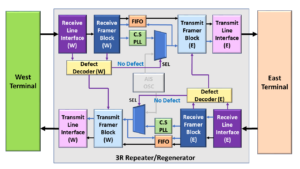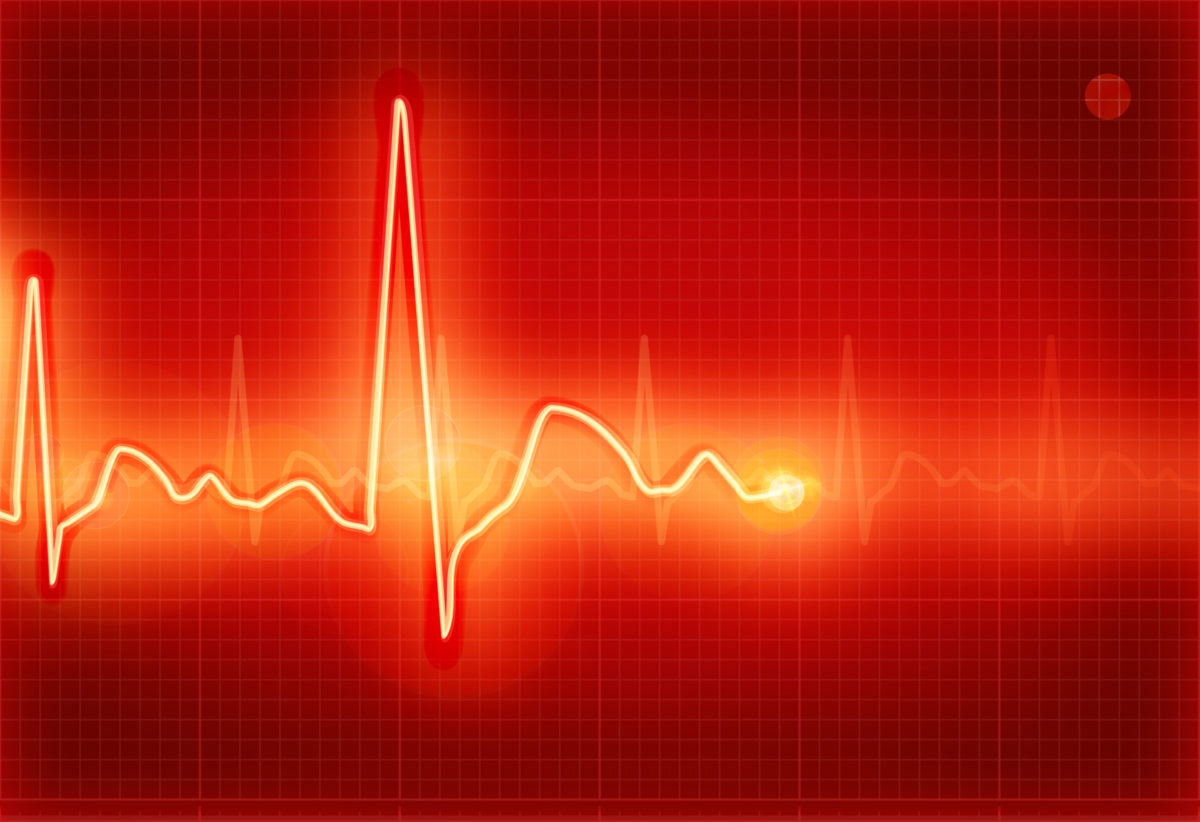What is the RDI (Remote Defect Indicator) Signal?
What does RDI Mean?
RDI is an acronym for Remote Defect Indicator.
Where is the RDI Signal Used?
RDI is a particular type of alarm signal that a Network Element (within a Telecom/Datacom application) will generate and transmit (back towards upstream Network Equipment) anytime it detects a servicing-affect defect within the signal from that same upstream Network Equipment.
Stated differently, the Network Element (NE) will transmit the RDI indicator (upstream) at the same time (and under the same conditions) that it will send the AIS signal downstream.
For example: If an NE were to declare the LOS (Loss of Signal) or the LOF (Loss of Frame) defect within its incoming telecom/datacom signal, then it will respond to this defect condition by transmitting the RDI signal (back) upstream towards the source of the defective signal.
Whenever the Network Element transmits this RDI signal upstream, it notifies the upstream NE that there are problems with its data.
What EXACTLY is an RDI Signal?
The method we use to transmit the RDI signal depends upon the telecom/datacom standard and network layer we use.
However, in most cases, the Network Element will transmit the RDI signal by setting a certain overhead bit-field (within the signal it is transmitting back to the remote or upstream NE) to “1”.
The Network Element will continue to set this bit-field to “1” within each data frame (transmitting back to the remote NE) for as long as it declares the defect within its incoming data stream.
Likewise, once the Network Element clears the service-affecting defect, it will stop sending the RDI signal by clearing that same overhead bit-field to “0”.
For OTN applications, we call the RDI signal the BDI (or Backward Defect Indicator) signal.
I have included posts that describe the BDI signal for both the OTUk and ODUk frames.
For example, SONET Line-Terminating Equipment will transmit the RDI-L indicator, and SONET Path-Terminating Equipment will send the RDI-P indicator.
In the case of PDH signals (e.g., T1/E1 or T3/E3), we call the RDI signal by other synonymous names such as FERF (Far-End Receive Failure) or the “Yellow Alarm.“
Clueless about OTN? We Can Help!! Click on the Banner Below to Learn More!!!
Discounts Available for a Short Time!!!
When do we transmit the RDI Signal?
We will use a couple of examples to illustrate how and when we transmit the RDI signal.
Example # 1 – The Unerred/Normal Condition
Figure 1 presents a simple illustration of a portion of a 3R Repeater/Regenerator, which consists of the following components:
- Two (2) Receive Line Interface blocks (one block is labeled W for West, and the other block is labeled E for East)
- Two (2) Receive Framer blocks (W – West and E – East)
- Two (2) Transmit Line Interface blocks (W – West and E – East)
- Two (2) Transmit Framer blocks (W – West and E – East)
- CS (Clock Smoothing/Jitter Attenuation) PLL (Phase-Locked Loop)
- AIS OSC (Stand-Alone Oscillator)
- FIFO/Buffer
- Two (2) Defect Decoder blocks (W – West and E – East)
In this figure, our 3R Repeater/Regenerator receives a good (error-free) signal from the West Terminal.
The 3R Repeater/Regenerator will first receive this signal through its Receive Line Interface (W) block.
Afterward, this signal passes through to the Receive Framer (W) block.
If the Receive Line Interface (W) and Receive Framer (W) blocks were to declare no problems within this signal. The 3R Repeater/Regenerator would allow this signal to pass through both the Transmit Framer (E) and Transmit Line Interface (E) blocks as is.
The Receive Line Interface (W) and the Receive Framer (W) blocks would also do nothing to alter the data that the Near-End Transmitter circuitry (e.g., the Transmit Line Interface (W) and Transmit Framer (W) blocks) is transmitting back out to the West Terminal.
Figure 1 presents an illustration of this Normal (No Defect) Condition.

Figure 1, Illustration of the 3R Repeater/Regenerator – during Good/Normal Conditions.
Please note that I have grayed out the non-relevant portions of Figure 1 to focus our discussion on this Defect Declaration to the RDI Generation mechanism on the West-side of the 3R Repeater/Regenerator circuit.
Let’s discuss the case where we will transmit the RDI indicator.
Example # 2 – The dLOS/Abnormal Condition
Figure 2 presents another simple illustration of a 3R Repeater/Regenerator.
However, in this figure, there is an impairment in the signal that originates from the West Terminal such that our Network Element is now declaring the dLOS (Loss of Signal) defect with this signal.
It is possible that a backhoe or some other mishap severed this signal.
Nonetheless, this means that our 3R Repeater/Regenerator is no longer receiving its signal from the West Terminal.
In this case, the 3R Repeater/Regenerator will respond by doing all the following:
- The Receive Line Interface (W) or the Receive Framer (W) blocks will declare the dLOS (Loss of Signal) defect with the signal that it is receiving from the West Terminal.
- The Transmit Framer (E) and the Transmit Line Interface (E) (which sit directly behind the Receive Line Interface and Framer blocks – that are declaring the dLOS condition) will now transmit the AIS indicator (to the East Terminal) as we discussed in the AIS post of this blog.
- Additionally, the Receive Line Interface (W) and/or the Receiver Framer (W) blocks will also command its “near-end” transmitting circuitry [e.g., the Transmit Framer (W) and Transmit Line Interface (W) blocks] to start sending the RDI signal, back out to the West Terminal.
Figure 2 illustrates the dLOS/RDI Transmission Condition for our 3R Regenerator/Repeater.

Figure 2, Illustration of the 3R Repeater/Regenerator – during the dLOS/Abnormal Condition
The Transmit Framer (W) and Transmit Line Interface (W) blocks will send the RDI indicator to the West Terminal for as long as the Receive Line Interface (W) and the Receive Framer (W) blocks declare the dLOS defect within the signal they are receiving from the West Terminal.
The Transmit Framer (W) and Transmit Line Interface (W) blocks will stop sending the RDI indicator once the Receive Line Interface (W) and the Receive Framer (W) blocks clear the dLOS defect and starts to receive good/normal data from the West Terminal.
In addition to the dLOS defect, the Network Element will transmit the RDI Indicator (upstream) in response to any other service-affecting defects, such as:
- OTN Applications (Sending the SM-BDI or PM-BDI Indicator)
- dLOF – Loss of Frame defect
- dLOM – Loss of Multi-Frame defect
- dLOFLANE – Loss of Frame defect for Logical Lane (for OTL3.4 or OTL4.4 applications)
- dLOL – Loss of Lane Alignment defect (for OTL3.4 or OTL4.4 applications)
- dLOFLOM – Loss of Frame and Multi-Frame defect (for Multiplexed Applications)
- dLOOMFI – Loss of OMFI defect (for Multiplexed Applications using an ODU4 server signal)
- dPLM – Payload Type Mismatch (for Multiplexed Applications)
- dTIM – Trail Trace Identifier Mismatch defect
Please check out the appropriate blog posts to learn more about the SM-BDI or PM-BDI indicators for OTN applications.
Why do we bother to transmit the RDI Signal?
The main reason we send the RDI signal (back to upstream equipment) in response to service-affecting defects is to alert that NE that there is a service-affecting defect within its output signal between its location and that of the next downstream NE.
This notification aids in troubleshooting and system debugging of fault conditions in the network.



